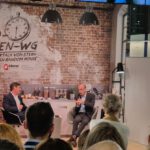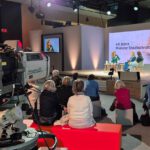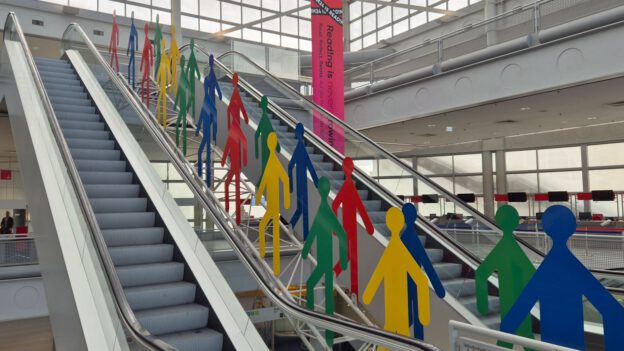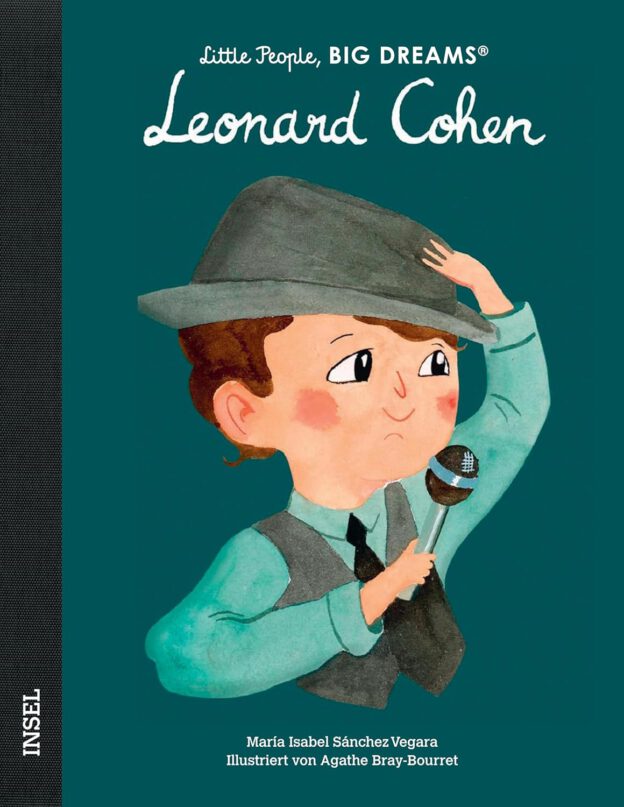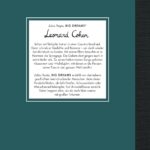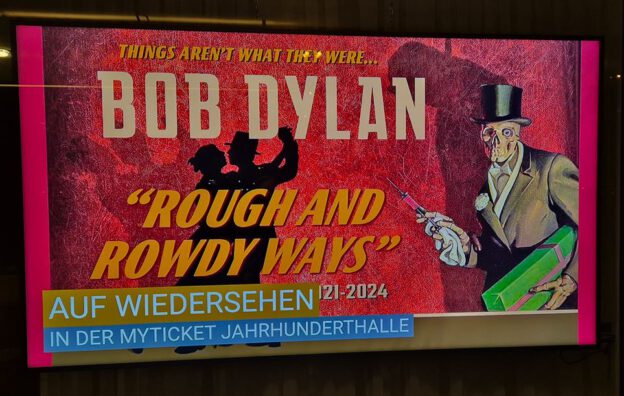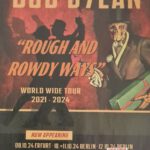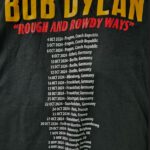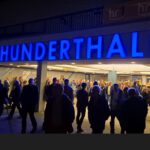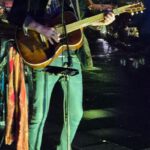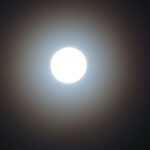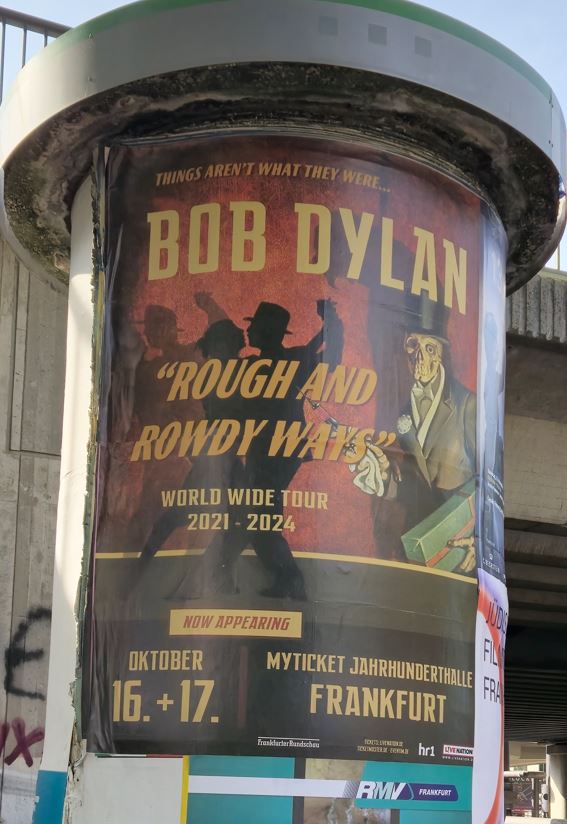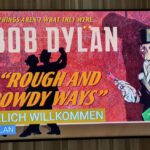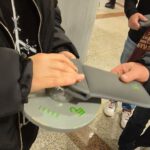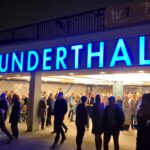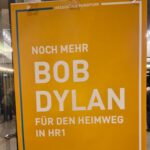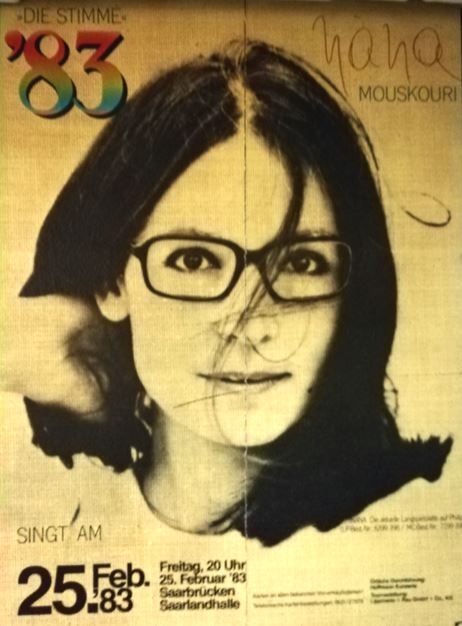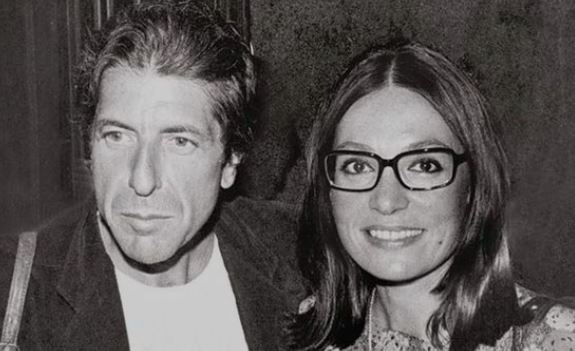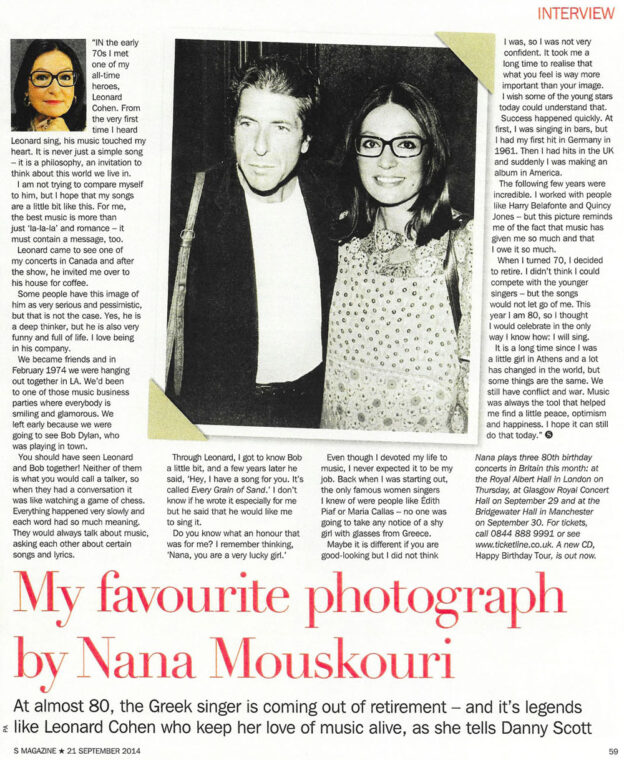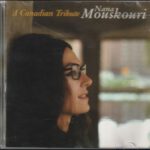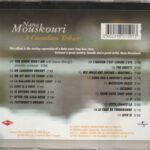„Every Grain Of Sand in Frankfurt“ (German Version, scroll down for English Version)
– Eigentlich wäre ich am Freitag, den 18.10.2024 bei Nick Cave und seinen „Bad Seeds“ in der Münchener Olympiahalle gewesen. Das Ticket hatte ich schon im April gekauft. Ende Juli hieß es plötzlich: Bob Dylan tritt im Rahmen seiner Tour im Oktober 2024 an mehreren Terminen in Deutschland auf. Soweit so gut. Aber ein paar Tage später hieß es auch noch: Aufgrund der großen Nachfrage wurden Zusatzkonzerte in Berlin und Frankfurt angesetzt. Für mich hieß das, mein Nick Cave-Ticket wieder in den Fansale zu geben und mich auf den dritten Abend der Dylanschen Konzert-Trilogie in Frankfurt einzustimmen.
Freitagabend, 18. Oktober 2024. Dylan macht sich von seinem Hotel, dem „Frankfurter Hof“ in der Stadtmitte auf den Weg in den Frankfurter Stadtteil Hoechst. Zu Gesicht bekam den Literaturnobelpreisträger in dem altehrwürdigen Gebäude der „Steigenberger-Hotelkette“, die während der Buchmesse der Literaten-Hotspot schlechthin ist, so gut wie niemand.
Frankfurt a.M., Freitagabend, 18. Oktober 2024 eine gute halbe Autostunde vom „Frankfurter Hof“ entfernt, derselbe Ort, die gleiche Zeit wie am Tag zuvor in der Jahrhunderthalle. Das Ritual kann beginnen. Ich bin gespannt, was sich gegenüber den zwei Vorabenden ändern wird und auch darauf, was sich nicht ändern wird. Geändert hat sich zumindest mein Sitzplatz. Nachdem ich am ersten Abend schon recht weit hinten auf dem Balkon saß, am zweiten Tag im Hochparkett saß, schaffe ich es am dritten Abend ins Parkett. Von hier habe ich eine ganz neue Perspektive, die wieder neue Blicke auf Bob Dylan offeriert. Ja, einfach nur Blicke auf Bob Dylan, nicht Blicke auf die Legende Bob Dylan. – Ich möchte Begriffe wie Legende, Ikone oder Mythos im Dylan-Kontext nicht mehr verwenden. Zu oft wird in den Medien noch immer von der Musiklegende, von der Ikone der Rockmusik oder gar vom Mythos Bob Dylan gesprochen, wenn versucht wird, das Gesamtwerk Dylans oder ein Konzert mit Worten zu beschreiben und das eigentlich nur selten gelingt. Bob Dylan ist einfach nur Bob Dylan oder auch nur Robert Allen Zimmerman aus Duluth, Minnesota. That`s it. Bob Dylan ist nur für die anderen Bob Dylan. Schließlich sagte er einmal nicht umsonst über sich selsbt: „Ich ist ein anderer“ in Anlehnung an Arthur Rimbaud. Vielleicht ist er aber auch einfach nur ein Überzeugungstäter des konsequenten und permanenten Rollenwechsels.
Der Verlauf des Abends bleibt wie der bereits erlebte. Smartphone-Verbot, zwei Gongs vor Konzertbeginn und die beiden Opener „All Along The Watchtower“ und „It Ain`t Me Babe“. Zeitweise sitzt er bei diesen ersten zwei Songs am Klavier. Zeitweise greift er dabei zur neben dem Klavier auf einem Hocker liegenden Gitarre. Die ganze Zeit der beiden Songs zeigt er sich nur mit dem Rücken zum Publikum. Dylans Performance hat Muster, wenn er sich nach der anfänglichen Verweigerung der Sicht-Kontaktaufnahme langsam öffnet und auf das Publikum im lyrischen Bluesgewand zugeht. Dann beginnt er es geradezu abzuholen, um es mit seinen ihm derzeit wichtigsten siebzehn live dargebotenen Songs in seinen Kosmos einzuladen.
Dieser Kosmos sieht im Parkett ein wenig anders aus, als auf den hinteren Rängen. Man achtet auf andere Konzertdetails. In den ersten fünfzehn Reihen ist das Licht heller. Zwei kleine Spots von der Bühnendecke leuchten die Menschen im Publikum dezent rötlich an. Würde jemand auf die Idee kommen, jetzt ein nicht in die Yondr-Pockets verschlossenes Smartphone zu zücken, um doch noch einen Schnappschuss vom Bühnengeschehen zu machen, man würde sofort als der Übeltäter schlechthin entlarvt werden. So geschehen in Berlin 2022, als man den Regelbrecher des Saales verwies, nachdem er schon recht früh versuchte, Fotos mit seinem Smartphone zu machen. Dylan mag das nicht. Dylan hat es noch nie gemacht, fotografiert zu werden, zumindest nicht in Momenten, in denen er das eben nicht mag. Von diesen Momenten gibt es viele. Konzerte gehören seit den 90er Jahren in das verbotene Zeitfenster von Fotos. In Frankfurt halten sich auch am dritten Tag alle an die Regeln. Und ja, ich gebe zu, ich würde der Versuchung auch gerne erliegen, ein Foto zu machen, fürchte aber die Folgen. Also konzentriere ich mich auf das Gesamtambiente. Dylan & Band (um Tony Garnier (electric and standup bass), Jim Keltner (drums), Bob Britt und Doug Lancio an den elektrischen und akustischen Gitarren) liefern dazu auf dem nun seit zwei Tagen gewohnt hohem musikalischen Niveau den Soundtrack für jene Eindrücke, die einem beim Blick durch Kamera-Objekte und Smartphone-Displays verwehrt sind. Die Bühne wirkt aus nächster Nähe betrachtet ein bisschen wie eine Werkstatt, wie ein Proberaum, wie ein Arbeitsplatz eben, an dem sich einige befreundete Musiker versammeln, um etwas zu jammen. Licht gibt es auf der Bühne kaum. Zwei große Film-Studio-Scheinwerfer, zwei kleinere Scheinwerfer und eine Handvoll wie Baustellenlampen wirkende Lichtquellen projizieren ausschließlich ungrelles schattenumwobenes Gelb im Umfeld von viel Dunkelheit. Hinten, rechts und links hängt ein in Falten gelegter Theatervorhang, der auch nur am Boden dezent angestrahlt ist.
Effekte, Lichtshows und Leinwände waren noch nie Bob Dylans Ding. Auf dem letzten Tourabschnitt der für drei Jahre angekündigten „Rough And Rowdy Ways“-Tour ist die visuelle Reduktion das Programm. Fotos davon benötigt Dylan nicht. Daher wohl auch das Pressefotografen- und Smartphone-Verbot. Bilder davon entstehen und bleiben im Kopf, wenn sich Dylan bei perfektem Klang mit brillanten Musikern umgebend durch sein aktuelles Oeuvre arbeitet. Das aktuelle Album steht unverändert im Mittelpunkt des eher literarisch wirkenden Spektakels. Je länger ich im Parkett sitze, umso mehr betrachte ich es als Geschenk, ein drittes Konzert in Folge am selben Ort erleben zu können. Darüber im Nachhinein zeitnah zu schreiben, erweist sich als kleine Herausforderung, wenn man von Dylans Performance und in diesem Falle zurecht gleichermaßen begeistert ist wie am Tag zuvor. Nichts war schlechter, eher alles noch besser, noch präziser und noch akkurater vorgetragen als bei den zwei Tagen zuvor. Jene, die nur an diesem einen Abend zugegen waren und sich auch nur auf ein einziges Dylan-Konzert 2024 einlassen, sehen den Abend womöglich mit anderen Augen. Einige wenige verließen tatsächlich schon nach einer Stunde die Halle.
Die, die 2024 noch immer die Klassiker suchen, werden weiterhin enttäuscht bleiben. Die, die einen episch-historischen Abend erleben möchten, sind zur rechten Zeit am rechten Ort, an diesem dritten Abend in der Frankfurter Jahrhunderthalle.
Die, die 2024 noch immer die Klassiker suchen, werden zumindest mit einigen älteren Songs wie „When I Paint My Masterpiece“, „To Be Alone With You“, „Desolation Row“, „It`s All Over Now, Baby Blue“ und „Watching The River Flow“ sowie mit dem Konzertfinale „Every Grain Of Sand“ in jeweils neuen Arrangements gegenüber den Originalen, besänftigt. Die, die einen episch-historischen Abend mit einem für seine Literatur mit einem Nobelpreis ausgezeichneten Ausnahmekünstler erleben möchten, lassen sich auf den Bob Dylan der Jetztzeit ein.
Und ja, der dritte Abend klingt einfach perfekt. Kein einziger schiefer Gitarrenton und ein perfektes stimmiges Klangbild bestimmen den Abend. Die Zeiten, in denen das Publikum rätselte, welchen seiner Songs er gerade wieder verfremdet oder gar mutwillig zerstört und manchmal noch nicht einmal seine Musiker wussten, welcher Song als nächster auf dem Programm steht, sind schon lange vorbei.
Dylan demonstriert auch heute einmal mehr, dass bei seinem Spätwerk die Musik eine eher begleitende Funktion hat. Ein bisschen wirkt das Konzert im Parkett wie eine Lesung der alten Beat-Dichter, die sich einst von leisen Jazz- und Blues-Tönen bei ihren Vorträgen begleiten ließen. 2024 lässt sich Dylan von manchmal sehr leisen, manchmal aber auch lauten, teils schnell und teils langsam gespielten Bluestönen begleiten. Das Blues-Schema unterstreicht er jeweils mit geradezu brachial einsetzenden Klavierpassagen wie z.B. bei „Crossing The Rubicon“, einer meiner Highlights an diesem Abend. Immer dann, wenn Dylan leise wird, wird es episch. Dann steht der 83Jährige vom Klavier auf und schreitet langsam einige Schritte zur Bühnenmitte. Dank der Nähe zur Bühne erkennt man sein Gesicht besser als von den hinteren Rängen. So mancher wird sich wünschen, mit 83 noch immer so viele Haare zu haben, wie Bob Dylan. Ja, die Haare sind dünner geworden, schwarz gefärbt, aber noch immer vorhanden. Hut oder eine andere seiner manchmal etwas skurril anmutenden und hutähnlichen Kopfbedeckungen trägt er bei der „Rough And Rowdy Ways“-Tour kaum und auch an diesem Abend nicht. Bob Dylan ist an diesem Abend gutgelaunt, was er nicht immer ist. Das Konzert wirkt nicht wie ein abzuarbeitender Pflichttermin. Die Band ist in Spiellaune. Jeder der Musiker wird wieder einzeln nach insgesamt vier Songs vorgestellt. Same procedure as yesterday and the day before yesterday. Der Hauptprotagonist ist in Redelaune. Er ist an diesem Abend geradezu gesprächig, weil man so manche „Thank Yous“ am Ende mehrerer Songs vernimmt.
Die Musiker tragen wieder alle einen schwarzen Anzug. Die Gitarristen Schiebermütze, Tony Garnier, der Bassist einen flachkrempigen Stetson-Hut. Dylan trägt einen dieser mit Ziermuster versehenen schwarzen Gehrockanzügen, der an jene erinnert, die man aus alten Westernfilmen kennt, wenn sich die Cowboys schick zum Salon machten. Darunter erkennt man wie am Vorabend ein schwarzes Hemd. Am Mittwoch trug er ein schwarz-weiß gemustertes Hemd darunter. Alles passt irgendwie zusammen, wenn Dylan zu seiner „Americana“ lädt. Aus der Nähe beobachtet man so vieles, was aus den hinteren Reihen nicht so gut zu erkennen ist. Dylan in Person. Nach jedem Song schlägt er z.B. in einem DINA 4 – Ordner neue Seiten auf. An den Mikrofonständer, der am vorderen Bühnenrand steht, tritt er nie. Nur beim Konzertende hebt er sich daran kurz fest. Ebenso gut zu erkennen ist Bobs Mimik. Konzentriert wirkt er bei jedem Lied. Das Gesicht verzerrt er ein wenig, wenn er die Worte in die Länge zieht. Und nicht selten lächelt er sogar, wenn er mit seinen Liedtexten das Wort an sein Publikum richtet.
Besonders episch wird es immer dann, wenn er aufsteht und sich auf dem Klavier abstützt. – Wenn er in der rechten Hand das Mikrofon an den Mund hält und sich mit dem linken Arm auf dem Instrument wie an einer Theke abstüzt. Die Szenen wirken dabei geradezu lässig, wenn er z.B. bei dem meditativ akustischen Folksong „Mother Of Muses“ die Belcanto-Methode anwendet. – Mit seinem prosodischen Gesang in der finalen Strophe singt er „Take me to the river, release your charms“ … oder „I’m travelin‘ light and I’m a-slow coming home“ und weiß damit den emotionalen Inhalt der Wörter in den Vordergrund zu stellen. Nein, er wirkt nicht predigend, wenn er stark artikulierend, kurze rhetorische Pausenmomente einfügt, um diese mit der Mundharmonika ausklingen zu lassen. Nach „Goodbye Jimmy Reed“ ist mit der Zitation der „Rough And Rowdy Ways“ Schluss.
Das wunderbare „Every Grain Of Sand“ markiert das Konzertende. Der Song, den er erst 2021 nach 2013 zum ersten Mal nach Jahren wieder live performt, steht für das Ende des Konzerterlebnis 2024 (nicht nur in Frankfurt). Leise, am Klavier sitzend versteht man fast jedes der Wörter, die wie dahin plätscherndes Wasser in einem Flussbett an uns vorbeifließen. Dylans letzte Worte „I am hanging in the balance of the reality of man/ Like every sparrow falling, like every grain of sand“ bekräftigen, dass dieses Lied eine Hymne für diesen Abend ist. Fernab seiner religiösen Bezüge beschreibt Dylan darin den Schmerz der Selbstwahrnehmung und die Ehrfurcht vor der Schönheit der Welt. „To see a world in a grain of sand/ And a heaven in a wild flower/ Hold infinity in the palm of your hand/ And eternity in an hour.“
Wenn ich bereits am zweiten Tag der Meinung war, dass es das perfekte Bob Dylan-Konzert der Jetztzeit war, sehe ich das dritte Frankfurter Konzert als ein weiteres perfektes Konzert an, nur eben aus einer anderen Perspektive in der Jahrhunderthalle. Danke, Bob, für knapp zwei Stunden (d)eine Welt in einem Sandkorn gesehen haben zu dürfen.
Eine Zugabe gibt es – wie derzeit gewohnt – nicht, braucht es auch nicht. Wie auch, bei einem solchen Finale? Das Licht wird nicht erhellt, Dylan steht für wenige Sekunden auf, verharrt weitere wenige Sekunden in der Bühnenmitte und verlässt wie gewohnt im Dunkel die Bühne.

„Every Grain Of Sand in Frankfurt“ (English Version)
„Every Grain Of Sand in Frankfurt“ – Actually, I would have been with Nick Cave and his „Bad Seeds“ in Munich’s Olympiahalle on Friday, 18.10.2024. I had already bought the ticket in April. At the end of July, it was suddenly announced: Bob Dylan will perform on several dates in Germany as part of his tour in October 2024. So far so good. But a few days later it was also said: Due to the great demand, additional concerts were scheduled in Berlin and Frankfurt. For me, this meant giving my Nick Cave ticket back to the fan sale and getting in the mood for the third evening of Dylan’s concert trilogy in Frankfurt.
Friday evening, October 18, 2024: Dylan makes his way from his hotel, the „Frankfurter Hof“ in the city center, to the Frankfurt district of F-Hoechst. Hardly anyone got to see the Nobel Prize winner for literature in the venerable building of the „Steigenberger Hotel Chain“, which is the literary hotspot par excellence during the book fair.
Frankfurt a.M., Friday evening, October 18, 2024, a good half an hour’s drive from the „Frankfurter Hof“, the same place, the same time as the day before in the Jahrhunderthalle. The ritual can begin. I am curious to see what will change compared to the two previous evenings and also what will not change. At least my seat has changed. After sitting quite far back on the balcony on the first evening, sitting in the high stalls on the second day, I make it to the stalls on the third evening. From here I have a whole new perspective, which offers new views of Bob Dylan. Yes, just looks at Bob Dylan, not looks at the legend Bob Dylan. – I don’t want to use terms like legend, icon or myth in the Dylan context anymore. Too often the media still talk about the music legend, the icon of rock music or even the myth of Bob Dylan when attempts are made to describe Dylan’s complete work or a concert in words and this rarely succeeds. Bob Dylan is just Bob Dylan or just Robert Allen Zimmerman from Duluth, Minnesota. That’s it. Bob Dylan is only Bob Dylan to the others. After all, it was not for nothing that he once said about himself: „I is somebody else“ in reference to Arthur Rimbaud. But perhaps he is simply a believer in the consistent and permanent change of role.
The course of the evening remains the same as the one already experienced. Smartphone ban, two gongs before the concert starts and the two openers „All Along The Watchtower“ and „It Ain’t Me Babe“. At times he sits at the piano during these first two songs. At times, he reaches for the guitar lying on a stool next to the piano. The whole time of the two songs he shows himself only with his back to the audience. Dylan’s performance has patterns when, after the initial refusal to make visual contact, he slowly opens up and approaches the audience in lyrical blues garb. Then he begins to pick it up in order to invite it into his cosmos with his seventeen songs that are currently most important to him, performed live.
This cosmos looks a little different in the stalls than in the back rows. You pay attention to other concert details. In the first fifteen rows, the light is brighter. If someone were to come up with the idea of pulling out a smartphone that is not locked in the Yondr pockets to take a snapshot of what is happening on stage, you would immediately be exposed as the culprit par excellence. This is what happened in Berlin in 2022, when the rule-breaker was expelled from the hall after he tried to take photos with his smartphone quite early on. Dylan doesn’t like that. Dylan has never done it to be photographed, at least not in moments when he doesn’t like it. There are many of these moments. Concerts have been part of the forbidden time window of photos since the 90s. In Frankfurt, everyone adheres to the rules on the third day. And yes, I admit, I would also like to succumb to the temptation to take a photo, but I fear the consequences. So I focus on the overall ambiance. Dylan & Band (around Tony Garnier (electric and standup bass), Jim Keltner (drums), Bob Britt and Doug Lancio on electric and acoustic guitars) provide the soundtrack for those impressions that are denied when looking through camera objects and smartphone displays on the high musical level that has been accustomed to for two days now. Viewed up close, the stage looks a bit like a workshop, like a rehearsal room, like a workplace where some musician friends gather to jam something. There is hardly any light on stage. Two large film studio spotlights, two smaller spotlights and a handful of light sources that act like construction site lamps project only unpleasant, shadowy yellow in the environment of a lot of darkness. At the back, right and left hangs a folded theatre curtain, which is only discreetly illuminated on the floor.
Effects, light shows and screens have never been Bob Dylan’s thing. On the last part of the „Rough And Rowdy Ways“ tour, which has been announced for three years, visual reduction is the program. Dylan doesn’t need photos of it. Hence the ban on press photographers and smartphones. Images of this arise and remain in the mind when Dylan works his way through his current oeuvre surrounded by brilliant musicians with perfect sound. The current album is still at the center of the rather literary spectacle. The longer I sit in the stalls, the more I consider it a gift to be able to experience a third concert in a row at the same venue. Writing about it in retrospect proves to be a bit of a challenge if you are just as enthusiastic about Dylan’s performance and in this case rightly as the day before. Nothing was worse, rather everything was even better, even more precise and even more accurately presented than on the two days before. Those who were only present on this one evening and only get involved in a single Dylan concert in 2024 may see the evening with different eyes. A few actually left the hall after just one hour.
Those who are still looking for the classics in 2024 will continue to be disappointed. Those who want to experience an epic-historical evening are in the right place at the right time, on this third evening in Frankfurt’s Jahrhunderthalle.
Those who are still looking for the classics in 2024 will at least be appeased with some older songs such as „When I Paint My Masterpiece“, „To Be Alone With You“, „Desolation Row“, „It’s All Over Now, Baby Blue“ and „Watching The River Flow“ as well as with the concert finale „Every Grain Of Sand“ in new arrangements compared to the originals. Those who want to experience an epic-historical evening with an exceptional artist who has been awarded a Nobel Prize for his literature get involved with the Bob Dylan of the present day.
And yes, the third evening sounds just perfect. Not a single crooked guitar note and a perfect coherent sound determine the evening. The times when the audience puzzled over which of his songs he was alienating or even wantonly destroying and sometimes not even his musicians knew which song was next on the program are long gone.
Dylan demonstrates once again today that music has a more accompanying function in his late work. The concert in the stalls seems a bit like a reading of the old Beat poets, who once let themselves be accompanied by quiet jazz and blues tones during their lectures. In 2024, Dylan will be accompanied by blues tones that are sometimes very quiet, but sometimes loud, sometimes played quickly and sometimes slowly. He underlines the blues scheme with almost brutal piano passages, such as in „Crossing The Rubicon“, one of my highlights of the evening. Whenever Dylan goes quiet, it gets epic. Then the 83-year-old gets up from the piano and slowly takes a few steps to the middle of the stage. Thanks to the proximity to the stage, you can see his face better than from the back rows. Some people will wish they still had as much hair at 83 as Bob Dylan. Yes, the hair has become thinner, dyed black, but still there. He hardly wears a hat or any of his sometimes somewhat bizarre and hat-like headgear on the „Rough And Rowdy Ways“ tour and not on this evening either. Bob Dylan is in a good mood this evening, which he is not always. The concert does not seem like a mandatory appointment to be worked through. The band is in the mood to play. Each of the musicians will again be introduced individually after a total of four songs. Same procedure as yesterday and the day before yesterday. The main protagonist is in a talking mood. He is downright talkative this evening, because you can hear some „Thank Yous“ at the end of several songs.
The musicians are all wearing a black suit again. The guitarists flat cap, Tony Garnier, the bassist a flat-brimmed Stetson hat. Dylan wears one of those black frock coat suits with a decorative pattern, reminiscent of the ones you know from old western films when the cowboys dressed up for the salon. Underneath you can see a black shirt, as on the previous evening. On Wednesday, he wore a black and white patterned shirt underneath. Everything somehow fits together when Dylan invites you to his „Americana“. Up close, you can observe so many things that are not so easy to see from the back rows. Dylan in Person. After each song, he opens new pages in a DINA 4 folder, for example. He never steps up to the microphone stand at the front of the stage. Only at the end of the concert does he briefly hold on to it. Bob’s facial expressions are just as recognizable. He seems concentrated with every song. He distorts his face a little when he drags out the words. And not infrequently he even smiles when he addresses his audience with his song lyrics.
It always gets particularly epic when he gets up and leans on the piano. – When he holds the microphone to his mouth in his right hand and supports himself with his left arm on the instrument as if at a bar. The scenes seem downright casual, for example when he uses the belcanto method in the meditatively acoustic folk song „Mother Of Muses“. – With his prosodic singing in the final verse, he sings „Take me to the river, release your charms“ … or „I’m travelin‘ light and I’m a-slow coming home“ and thus knows how to put the emotional content of the words in the foreground. No, he doesn’t seem preachy when he inserts short rhetorical pauses in a strongly articulate way, only to end them with the harmonica. After „Goodbye Jimmy Reed“, the citation of the „Rough And Rowdy Ways“ is over.
The wonderful „Every Grain Of Sand“ marks the end of the concert. The song, which he will only perform live in 2021 for the first time in years after 2013, stands for the end of the concert experience in 2024 (not only in Frankfurt). Quietly, sitting at the piano, we understand almost every one of the words that flow past us like rippling water in a riverbed. Dylan’s last words „I am hanging in the balance of the reality of man/ Like every sparrow falling, like every grain of sand“ affirm that this song is an anthem for this evening. Far from his religious references, Dylan describes the pain of self-perception and reverence for the beauty of the world. „To see a world in a grain of sand/ And a heaven in a wild flower/ Hold infinity in the palm of your hand/ And eternity in an hour.“
If I was already of the opinion on the second day that it was the perfect Bob Dylan concert of the present day, I see the third Frankfurt concert as another perfect concert, just from a different perspective in the Jahrhunderthalle. Thank you, Bob, for being able to see (your) world in a grain of sand for almost two hours.
There is no encore – as usual at the moment – and there is no need for it. How could he, in such a final? The light is not illuminated, Dylan stands up for a few seconds, remains in the middle of the stage for another few seconds and leaves the stage as usual in the dark.
Die Setlist:
| 1. |
All Along the Watchtower (Bob on guitar and baby grand piano) |
| 2. |
It Ain’t Me, Babe (Bob on guitar, baby grand piano and harp) |
| 3. |
I Contain Multitudes (Bob on baby grand piano) |
| 4. |
False Prophet (Bob on baby grand piano) (Bob introduced Bob Britt at the end) |
| 5. |
When I Paint My Masterpiece (Bob on baby grand piano and harp) |
| 6. |
Black Rider (Bob on baby grand piano) |
| 7. |
My Own Version Of You
(Bob on baby grand piano) (Bob introduced Doug Lancio at the end) |
| 8. |
To Be Alone With You
(Bob on baby grand piano) (Bob introduced Tony Garnier at the end) |
| 9. |
Crossing the Rubicon (Bob on baby grand piano) |
| 10. |
Desolation Row
(Bob on baby grand piano and harp) (Bob introduced Jim Keltner at the end) |
| 11. |
Key West (Philosopher Pirate) (Bob on baby grand piano) |
| 12. |
It’s All Over Now, Baby Blue (Bob on baby grand piano and harp) |
| 13. |
I’ve Made Up My Mind To Give Myself To You
(Bob on baby grand piano and harp) |
| 14. |
Watching the River Flow (Bob on baby grand piano) |
| 15. |
Mother of Muses (Bob on baby grand piano) |
| 16. |
Goodbye Jimmy Reed (Bob on baby grand piano and harp) |
| 17. |
Every Grain of Sand (Bob on baby grand piano and harp) |
